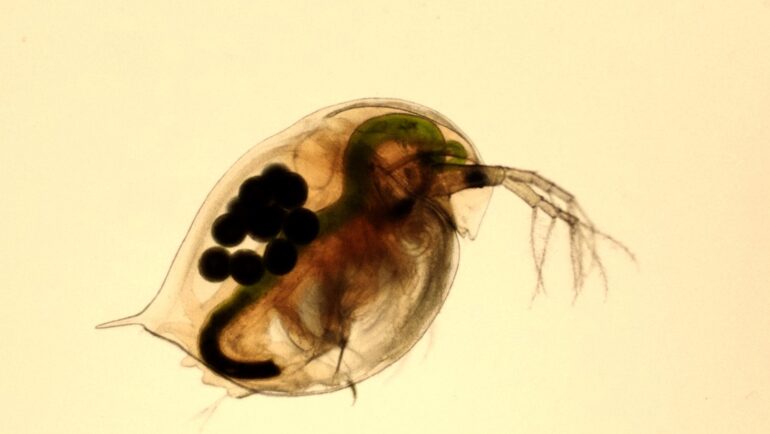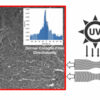A new study into how sunscreen affects freshwater ecosystems suggests the impact may be less alarming than first thought—and raises new questions about whether lab-based studies into environmental contaminants are accurately reflecting what happens in the wild.
“There’s a bit of a disconnect between how we try to study contaminants and environmental problems in the lab environment and what actually are the likely outcomes in the real world,” says Aaron Boyd, lead author of the study and Ph.D. candidate in the University of Alberta’s Department of Biological Sciences.
“One of the main goals of this project was to see if our simple lab models are actually lining up with what we would expect to see in a natural environment.”
In 2020, Boyd was part of research supervised by assistant professor and senior author Tamzin Blewett, which showed that exposing the Daphnia magna species of water fleas to ultraviolet filters, or UVFs, over a two-week period was fatal to the tiny crustaceans.
In this follow-up study, the team wanted to see what would happen if five generations of the fleas were exposed to certain UVFs. They learned that the species became acclimatized to the contaminants over time.
Organic UVFs are found in many skin care products like sunscreen and lip balms, and they leach off our skin into the water. A growing number of tourist destinations, including Aruba, Palau, Thailand and Hawaii, have already banned sunscreen with UVFs.
However, while short-term studies show that UVFs could pose a risk to invertebrate species such as coral, few longer-term studies have been done.
A long-term approach
Most toxicity tests take place over two to 21 days, but Boyd’s most recent study spanned nearly three months, observing effects of exposure over five generations of fleas. All were exposed to the same concentrations of chemicals, which mirrored the high side of what could reasonably be found in the environment.
The findings showed that mortality rates dropped with each generation. Two-thirds of the first-generation fleas were killed, with that number dropping to one-third in the second generation and virtually zero in the third, fourth and fifth generations.
Newborn water fleas were exposed during parental exposure—not something usually observed in shorter-term studies, the researchers note.
“That three-week exposure lets us see how it affects their development when they’re young and how it affects their ability to reproduce and carry the population forward,” says Boyd.
Although the findings prove that the mortality rates decreased, it’s not known how the aquatic fleas became acclimatized to the UVFs or whether the substances caused any ill effects in later generations.
“Daphnia did acclimate and they did survive the entire time, but we don’t know if they’re still in the same health condition as they were before the exposure,” says Boyd.
A biological process called phenotypic plasticity governs an organism’s ability to change which genes are active at any given moment in response to particular environmental conditions. In Daphnia’s case, if the acclimatization was successful but required too much of its energy, there could be eventual repercussions, Boyd says.
“They could be alive but extremely susceptible to a second stressful event,” like a new contaminant or a heat wave, he says.
Blewett and her team are collaborating with assistant professor Glen Uhrig in the biology department for the project’s next steps—examining Daphnia’s tissue samples and changes to its proteins. This information helps signal which genes are active and which are not.
“It lets us see exactly how they’re responding to the presence of these contaminants,” says Boyd. “That will help us determine the actual mechanisms through which this acclimatization is happening.”
‘The canary in the coal mine’
Invertebrate species like Daphnia aren’t as complex as fish or mammals; as a result, they’re more sensitive to environmental contaminants, says Boyd.
“Humans are exposed to a lot of contaminants all the time, but it’s not an issue for us because our body can break down these chemicals and remove them quite efficiently. Less complicated organisms don’t have the same ability to do that,” he says.
This sensitivity makes them “the proverbial canary in the coal mine” for studying the impact of UVF exposure.
“If the most sensitive species don’t have any issues with these chemicals, that’s a good indication that these aren’t things we need to worry about,” says Boyd. “If we do see sensitivity, that means we have to study them further, do more testing—especially on other species that might not be so sensitive—so we can get a good idea of the extent of the problem.”
Other species used to study exposure to toxicants, such as zebrafish, are only present in certain parts of the world, but Daphnia are found in freshwater lakes globally.
The new research, now published in the Journal of Hazardous Materials, suggests short-term studies may be overestimating the level of long-term toxicity that UVFs have on Daphnia magna. But there are broader implications as well, Boyd says, noting that the alarming results from short-term studies are influencing policies to protect sensitive invertebrate species even though those studies may not accurately represent long-term outcomes.
Boyd says the new findings also have him questioning whether UVFs—particularly given their importance in protecting skin from harmful sun exposure—might not be the most pressing concern for environmental researchers.
“These UVFs are something to monitor, and if concentrations in the environment increase further they’re certainly a concern,” he says.
“But I think that because they’re primarily a concern for a very specific species, and they do provide a large benefit to human health directly, that there are more toxic chemicals in the environment we could be allocating our limited research resources to instead.”
More information:
Aaron Boyd et al, Can short-term data accurately model long-term environmental exposures? Investigating the multigenerational adaptation potential of Daphnia magna to environmental concentrations of organic ultraviolet filters, Journal of Hazardous Materials (2022). DOI: 10.1016/j.jhazmat.2022.130598
Provided by
University of Alberta
Citation:
Long-term study shows water fleas adapt to sunscreen ingredients (2023, March 24)



